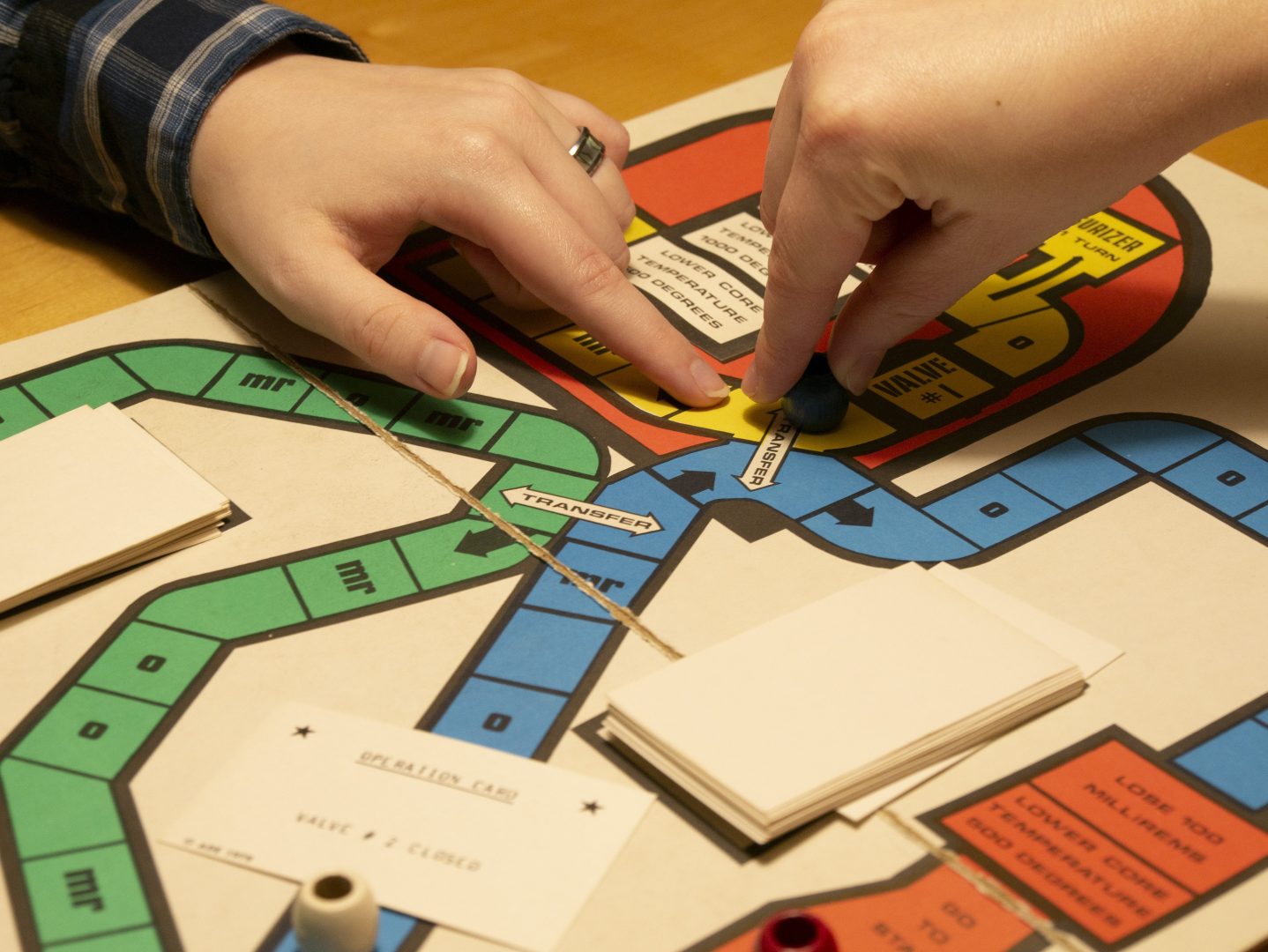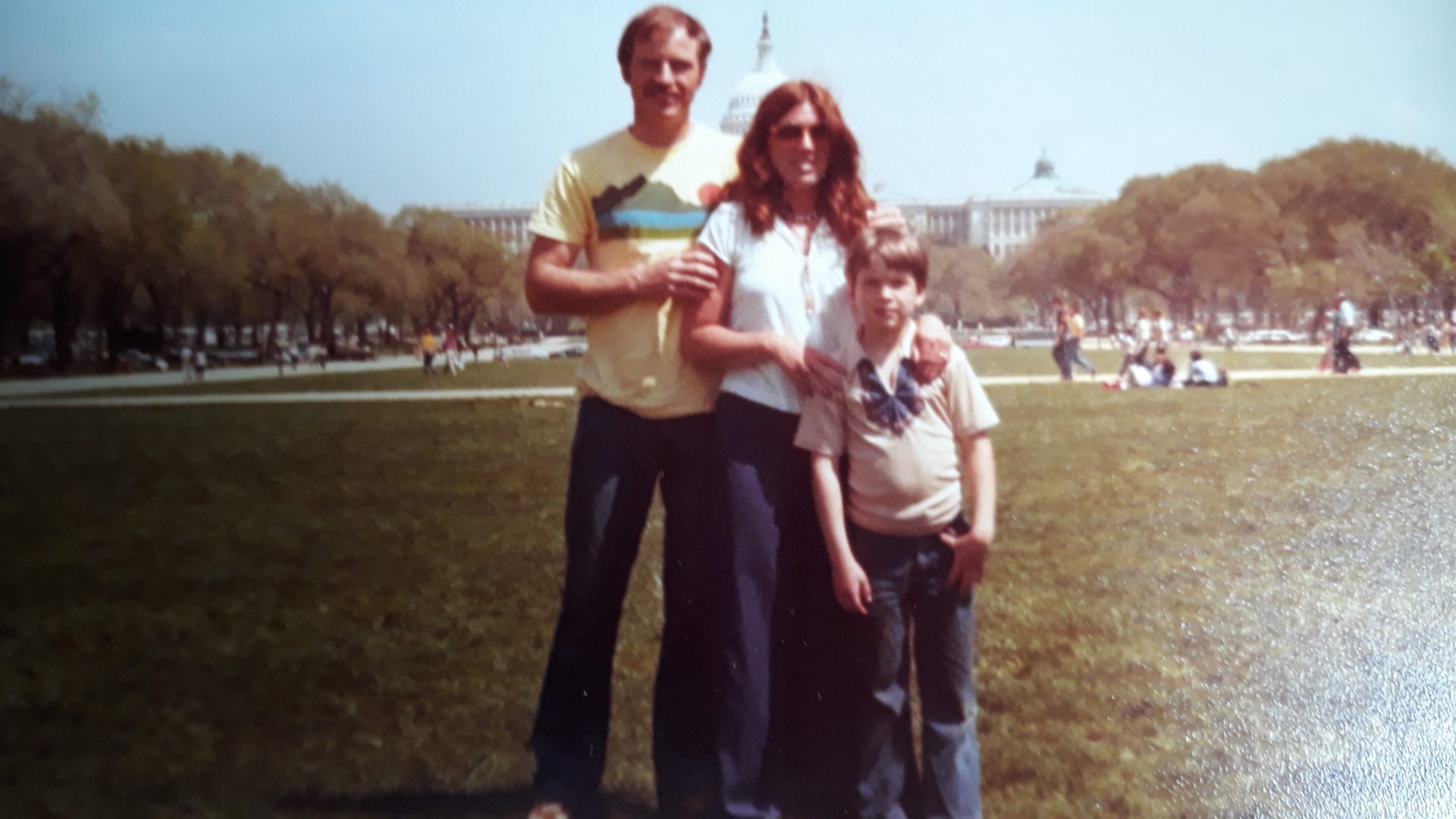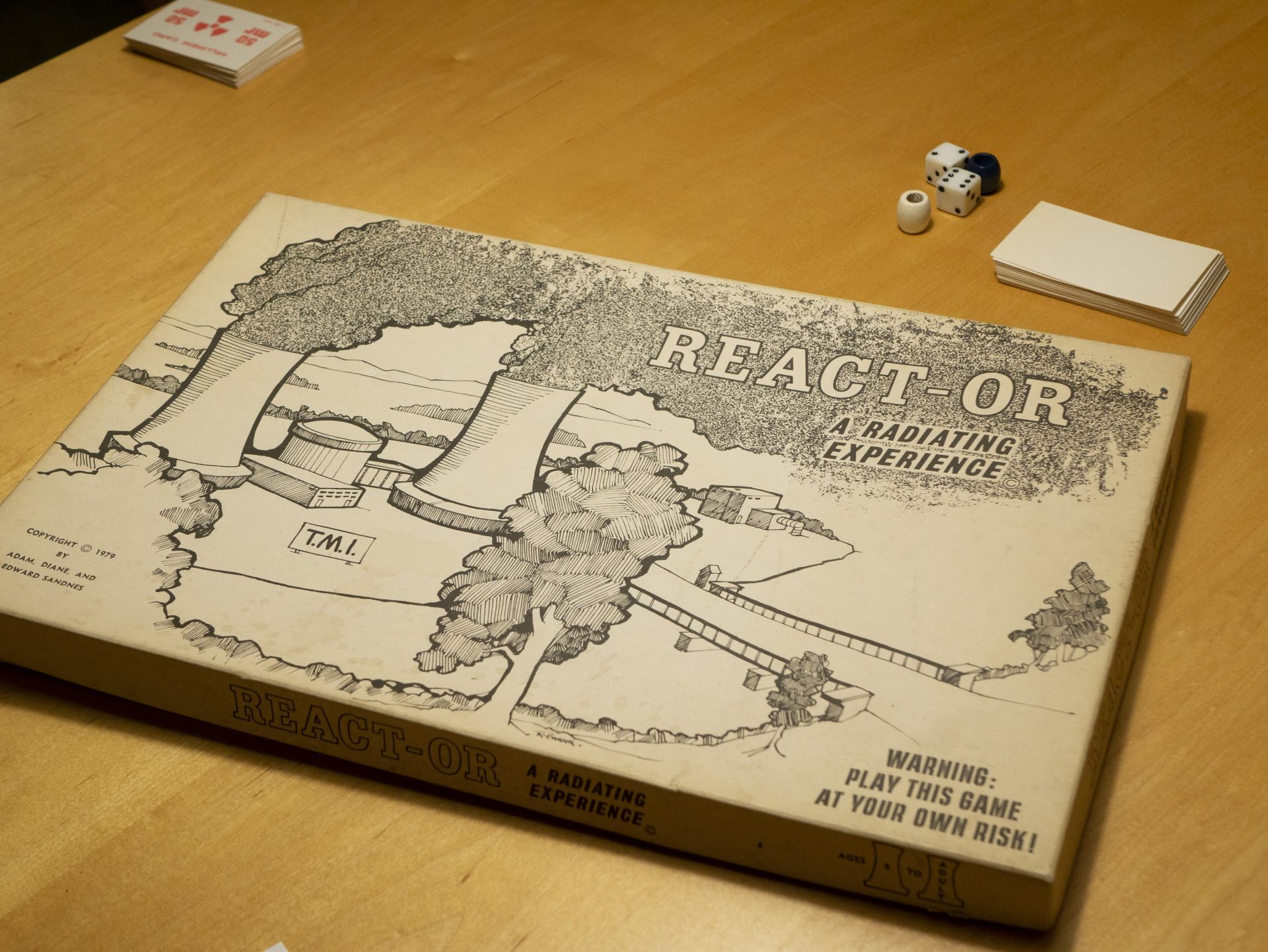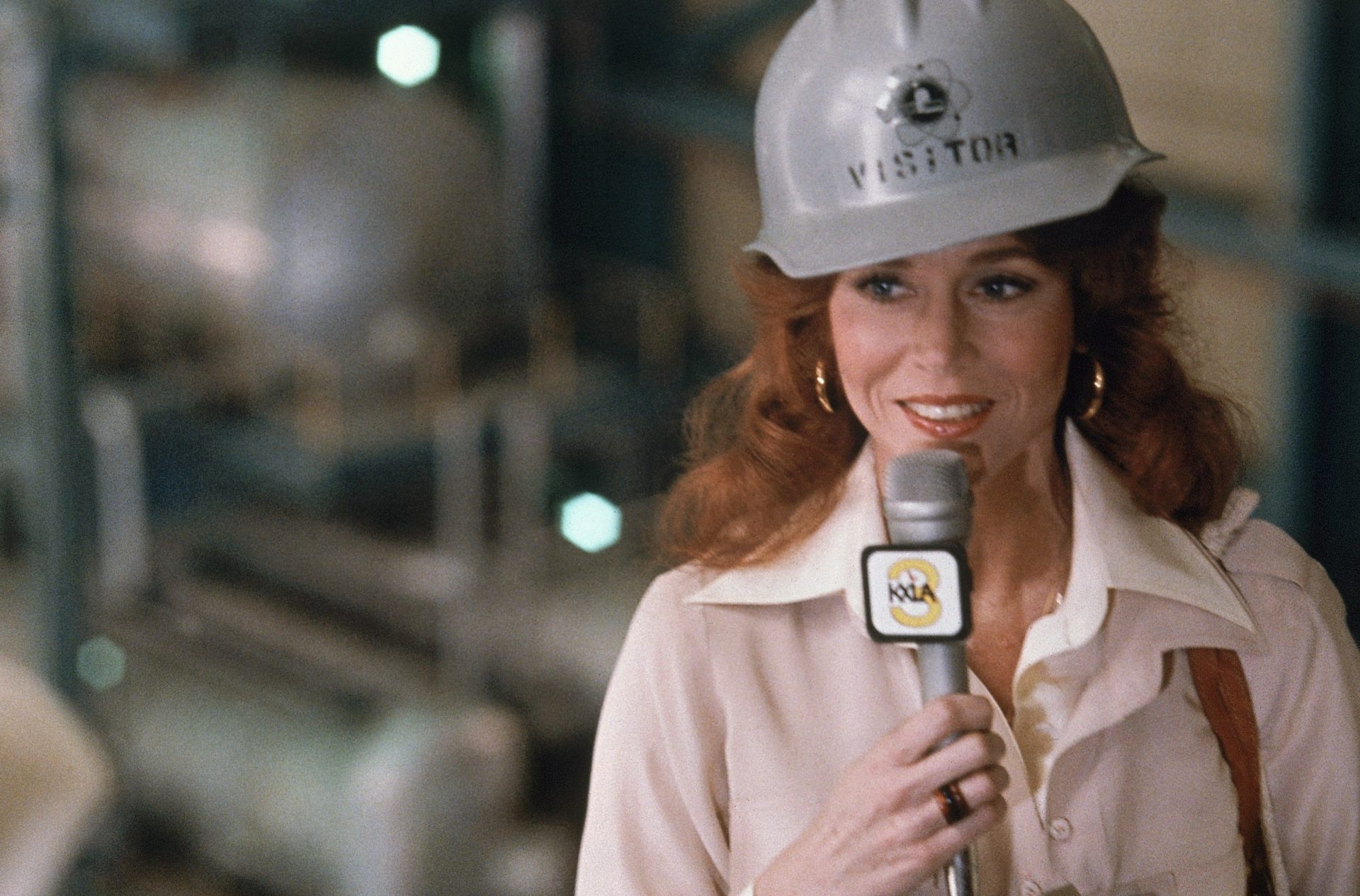
Lisa Wardle and Marie Cusick play the REACT-OR board game at Dickinson College.
Tom Downing


Lisa Wardle and Marie Cusick play the REACT-OR board game at Dickinson College.
Tom Downing

Tom Downing
Lisa Wardle and Marie Cusick play the REACT-OR board game at Dickinson College.
Diane Sandnes was nervous about living only a few miles from a nuclear plant. So on March 28, 1979, when she heard there was an accident at Three Mile Island, she decided it was safest to keep her 6-year-old son, Adam, indoors.
“We just didn’t like the reports coming out of there,” Edward Sandnes recalled. “We never kind of trusted government.”

Courtesy of the Sandnes family
Edward, Diane and Adam Sandnes attend a Three Mile Island protest in Washington, D.C.
The family followed news coverage, and Adam played to pass the time. At one point, he pretended two foam cups on the coffee table were the nuclear reactor’s cooling towers, and he come up with his own game inspired by the events unfolding around him.
When officials later recommended children stay inside, the family left Etters to stay with family in Williamsport. But after returning home, they revamped that foam cup game into something a little more produced.
Edward was a science teacher at York Catholic, so he incorporated his knowledge of reactors and cooling loops into the game. The family also created event cards based on news reports they had seen on TV.
Players roll two dice to make their way around the cooling loops, trying to avoid exposure to radiation as they travel. The game ends when the reactor reaches either cold shutdown or meltdown, and the player with the least accumulated radiation wins.
“The assembly of the game was done in our kitchen and living room,” Edward said. “We glued all the parts together by hand and we had, you know, all the cards had to be collated and you know, it was a massive project. We hand-built every game.”
The Sandnes family called it REACT-OR and made about 300 games. After shopping it around to family and friends, they approached local stores about putting up small displays. Each brought in a few more sales.
They sold about 100. Today, unsold boxes sit in the Sandnes’ attic. You can find a few copies elsewhere in central Pennsylvania, such as one in Dickinson College’s Archives and Special Collections, but it’s hard to find because it never reached mass production.
Edward wrote to game manufacturers like Hasbro and Parker Brothers. He heard back from only one company. The letter said they had in-house designers and did not need any outside help. Edward also wonders if releasing the game just months after the accident worked against them.
“Maybe it would be better now to try to sell the game because it’s in your past,” he said. “It’s not raw nerves.”

With the rise of the nuclear energy industry in the United States came books, films and television programs about the topic. The focus shifted from nuclear warfare to nuclear power plants just like the ones people saw going online in a few cities across the United States. Many of those fictional works portrayed disasters and cover-ups at nuclear plants.
Author Harold King published the novel Paradigm Red in 1975, in which an explosion occurs at a nuclear reactor plant and there is evidence of sabotage. CBS adapted the book into made-for-TV movie Red Alert. Then came The Chosen, about a nuclear power plant executive whose son happens to be the antichrist.
But the best-known film about nuclear power was released just 12 days before the incident at Three Mile Island.
The China Syndrome, starring Jane Fonda, Jack Lemmon and Michael Douglas, told the tale of a problem at a reactor in California, a cover-up, and a group of people determined to uncover the truth. Both the timing and its plot forever linked the film and Three Mile Island accident in many people’s minds.
Michael Douglas talked to People magazine about the similarities in April 1979:
“When screenwriter Mike Gray originally talked about the script, I was curious to know how realistic the scenario was. He told me it would be a race between getting the movie made and a major disaster. The Three Mile Island situation really brings the point home. It’s an eerie feeling.”
After the accident, Dickinson College teacher Lonna Malmsheimer worked with a group of students and other instructors to interview central Pennsylvanians. They interviewed about 400 people over the course of six months.
One thing Malmsheimer noticed was how many people turned to fiction to make sense of the real-world events around them.
“They didn’t have any experience with it. They didn’t know anybody that had any experience with it,” she said. “So they had to go with what they had, and what they had was popular culture, religion and humor.”
Two particular films kept being referenced in those interviews: War of the Worlds and The China Syndrome. Though the former wasn’t focused on nuclear power plants, people connected with the chaos and confusion they experienced immediately after the accident.
Sharon Kerstetter was a senior at Indiana University of Pennsylvania in 1979 when she and some friends saw The China Syndrome. They went to the theater on March 28, the same day as the partial meltdown at Three Mile Island.
“After we got home, we turned on the TV. And there was basically The China Syndrome here at Three Mile Island,” she said. “And it was it was really very upsetting because this was — what we were hearing was exactly what we had just seen in the movie.”
“They didn’t have any experience with it … So they had to go with what they had, and what they had was popular culture, religion and humor.” – Lonna Malmsheimer
It didn’t help that one line in the film mentioned an exposed core could “render an area the size of Pennsylvania permanently uninhabitable.”
Kerstetter was worried about her family, who lived near the plant. She felt safe in the western part of the state, but she hoped her family would evacuate. They decided to stay.

AP file
Actress Jane Fonda is shown during the filming of her movie “The China Syndrome” in which she plays the part of a television reporter in 1979.
“I think seeing the movie almost made me assume that the worst was happening, and that there would be a cover-up,” she said.
Ellen Wascau was the news and public service director at WLAN and FM 97 in Lancaster in 1979. She worked day and night after the accident to answer phone calls from confused and scared listeners, and to provide on-air updates as the events unfolded.
She said sometimes employees slept at the station, or she would sneak over to her parents’ house a block away for a quick nap.
About one week after the accident, the flow of news had calmed down. One day, she and a small cohort from the station went to a nearby theater to see The China Syndrome. They didn’t get to see the whole film, though.
“Something happened at the plant again, and the theater management found us and, you know, we all went right back to work,” she said. “But it was really interesting. It was a little bizarre to be watching this film about something very similar to what was going on in real life.”
At the same time people were turning to pop culture to make sense of the accident, so too did artists and performers.
On April 7, 1979, Saturday Night Live included a sketch titled “The Pepsi Syndrome”— a skit with references to both the Hollywood film and the Three Mile Island partial meltdown, including a press conference and President Jimmy Carter’s visit. In the sketch, President Carter (portrayed by Dan Aykroyd) enters the reactor core and emerges as an irradiated giant.
The skit built off growing concern that high levels of radiation could permanently alter the cellular makeup of any person or animal exposed to it.
Another major concern about nuclear power plants—the potential for human error—can be seen on The Simpsons. The blundering Homer Simpson works at Springfield Nuclear Power Plant and leaves viewers to believe an accident could occur at any time. The coldhearted Montgomery Burns, who owns the plant, always puts his business first, not the safety of Springfield’s citizens.
In the first episode, “Simpsons Roasting on an Open Fire,” Homer inspects various meters and signs off on each, despite one registering at a dangerous level and another one flashing a red warning light.
“They’re just so many other parts of pop culture where it turns up, whether it’s board games or video games, films.” – Sean Kilcoyne
The film industry also capitalized on growing concerns about the nuclear industry, with six movies released in the year after the accident at Three Mile Island. That catalog includes weird creature features like Island Claws to action flicks like Chain Reaction, in which an employee tries to warn the public about a leak at an Australian nuclear waste facility.
Musicians were also inspired by the accident, in some cases crossing platforms to spread their message.
Jackson Browne, Graham Nash, Bonnie Raitt, John Hall and Harvey Wasserman formed Musicians United for Safe Energy and organized the MUSE Concerts for a Non-Nuclear Future at Madison Square Garden. They also turned those performances into the film No Nukes.
Musicians across the globe crafted songs about Three Mile Island and nuclear energy at large. The topic was well-suited for a range of genres, from folk protest songs to political punk to metal to comedic spoofs.

Courtesy of Sean Kilcoyne
Sean Kilcoyne and his sister are seen in this 1979 photo. The family lived in Hummelstown.
Tom Quinn and Sean Kilcoyne were young boys living in central Pennsylvania in 1979. They didn’t understand what was happening at Three Mile Island, they just knew the adults around them were scared. Though they shared similar experiences and were both involved in the central Pennsylvania music scene in the 1980s, they didn’t connect until five years ago.
The men have since catalogued hundreds of Three Mile Island-inspired tracks. You can listen to these “radioactive releases” on their blog.
“I’ve always collected music and classified it and made lists,” said Quinn, who runs a music blog called tapewrecks. “And, you know, so this was just a fascinating genre of music that I thought hadn’t been explored.”
The passion project started after a friend shared the 1979 song (Potter County Was Made By the Hand of God, But the Devil Made) Three Mile Island by Al Shade and Jean Romaine.
At the time, Quinn thought the topic would make a good blog post if he could find a couple of other songs to include with that track. He said he “started looking them up, and very quickly found, you know, 20, 30 and, you know, just increased over the past five years.”
Kilcoyne first noticed nuclear energy as a recurring theme in the 1980s as he collected records and attended live shows.
Once he connected with Quinn, that lingering interest turned into a full-blown obsession. They have found over 400 songs, he said, and he thinks there are more.
Even 40 years later, Three Mile Island continues to find its way into popular culture. Nearly 100 of the songs Quinn and Kilcoyne have found were produced within the last decade. In that same timeframe, the nuclear power plant has been featured in X-Men Origins: Wolverine, a video game, a smartphone game and a themed escape room in Philadelphia.
“They’re just so many other parts of pop culture where it turns up, whether it’s board games or video games, films,” Kilcoyne said. “I know in my work as a film archivist and projectionist, I was projecting a 35-millimeter print of Cannonball Run about a year ago, and I hadn’t ever seen the film. And there was just this line in it, that this guy was like, shouting, you know, ‘This is going to be our Love Canal, this is going to be our Three Mile Island!’”
StateImpact Pennsylvania is a collaboration among WITF, WHYY, and the Allegheny Front. Reporters Reid Frazier, Rachel McDevitt and Susan Phillips cover the commonwealth’s energy economy. Read their reports on this site, and hear them on public radio stations across Pennsylvania.
(listed by story count)
StateImpact Pennsylvania is a collaboration among WITF, WHYY, and the Allegheny Front. Reporters Reid Frazier, Rachel McDevitt and Susan Phillips cover the commonwealth’s energy economy. Read their reports on this site, and hear them on public radio stations across Pennsylvania.
Climate Solutions, a collaboration of news organizations, educational institutions and a theater company, uses engagement, education and storytelling to help central Pennsylvanians toward climate change literacy, resilience and adaptation. Our work will amplify how people are finding solutions to the challenges presented by a warming world.